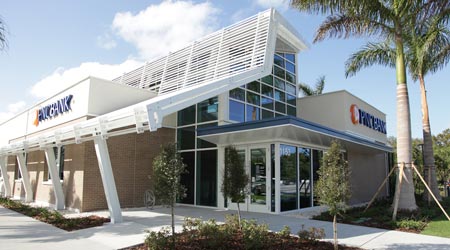 PNC Financial Services Group opened its first zero net energy branch
in Fort Lauderdale, Fla., in 2013. The 4,900-square-foot branch was
the first ZNE project completed as part of the DOE’s Net Zero Energy
Commercial Building Initiative. Credit: Paladino and Company.
PNC Financial Services Group opened its first zero net energy branch
in Fort Lauderdale, Fla., in 2013. The 4,900-square-foot branch was
the first ZNE project completed as part of the DOE’s Net Zero Energy
Commercial Building Initiative. Credit: Paladino and Company.Strategies for Scaling Up To Zero Net Energy Buildings
First of a four-part article on baseline techniques for making zero net energy buildings more common.
Zero net energy is the future of high-performance buildings. Advancing research and development of zero net energy (ZNE) buildings, which produce as much energy — and often more — than they use on an annual base, will be a major contributor to mitigating climate change, and support the goals set by the COP21 agreement in Paris last December.
In response to the Paris agreements, the World Green Building Council (WorldGBC) and its 27,000 member companies recently announced a program, Advancing Net Zero, with the ambitious goal for all buildings to achieve ZNE. The program also committed to reduce carbon dioxide emissions from the buildings sector by 84 gigatons by the year 2050.
This is a massive, worldwide undertaking. If the WorldGBC has its way, all new building construction should be meeting zero net energy by 2030. Achieving a ZNE building presents more obstacles than mainstream green building practices, but it is possible to achieve zero net energy in volume. So how do we make zero net energy common practice?
While improving the energy performance of individual buildings is a step in the right direction, ZNE strategies should be considered at scale. Organizations that construct a large volume of small buildings and own them long-term should consider ultra-efficient ZNE buildings.
PNC Financial Services Group, as one example, has begun exploring ZNE strategies, applying lessons learned and technologies from its first ZNE bank branch in Ft. Lauderdale, Fla., to other signature green bank branches in its real estate portfolio. The opening of the ZNE bank branch in January 2013 was a crowning achievement that took more than two years of design and collaboration with the Department of Energy (DOE) and Pacific Northwest National Laboratory.
The 4,900-square-foot branch was the first ZNE project completed as part of the DOE’s Net Zero Energy Commercial Building Initiative, which aims to significantly improve the energy efficiency of new and existing commercial buildings. PNC used a combination of solar energy, solar shading, daylighting, efficient HVAC systems, sustainable waste management practices, and direct current power for interior lights, building controls, and sensors to achieve ZNE performance.
DOE’s initiative challenged PNC to develop a retail branch bank that was 50 percent more energy efficient than energy code, with a goal of accelerating market adoption of energy efficient building technologies and solutions. PNC has a strong sustainability drive, and the company made the decision to stretch the project goal to incorporate a ZNE target.
Energy forensics, simulation research, and design integration yielded surprising results, and led to the engagement of a broad project team, including PNC’s IT department, which had previously not been engaged in building design and construction. Energy modeling also was conducted to evaluate how the ZNE strategies would perform in different climate regions to help the team select the ideal site.
The approach was to first reduce energy loads of the prototype design by 50 percent; then meet the remaining demand through renewable power. The design team first addressed architecture and building systems to drive down energy loads. A basis of design was developed for the lighting scheme that led to changes yielding over 50 percent in lighting energy reduction, as well as incremental savings to cooling energy demands. Finally, the team engaged additional collaborators from PNC to reduce operational energy uses. An organization-wide mindset change was essential to achieve net zero energy.
A seemingly simple plug load study at existing branches taught the team a significant lesson about the role of computer equipment. The team worked with PNC’s IT department to research and specify all new computer equipment, which consumes less energy without compromising performance. Only once energy loads were minimized as much as possible through thoughtful design processes did the team consider adding renewable energy technology as a final measure.
Feasibility studies helped determine the most appropriate method of energy production and technology. Estimated solar output calculations supported recommendations for PV panel placements based on cost, visibility, and size. The branch is now powered by 211 of the most efficient photovoltaic panels on the commercial market.
Critical lessons learned throughout the project are applied to new PNC branches as part of its comprehensive green building program, even those not targeting net zero. The branch achieved a LEED Platinum rating in 2014, and in 2016, earned the ZNE Petal of the Living Building Challenge.
Related Topics:















